|
Blood purification for cancer,
diabetic and heart disease patients
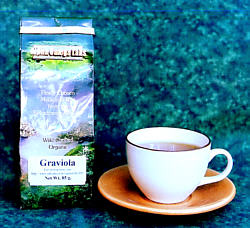
Graviola
(Annona muricata)
Tea Leaves of
Graviola (Soursop)
Code 322 -- Price: $4.95
Tea Leaves: 85 gr. (net wt)
Makes 4 Gallons of Tea
(Using 21 g. ≅ 9 T. to make a gallon)
Code 322C -- Price: $18.95
120 Capsules x 500 mg.
Order Now
 Email
Email
 Summarized Description:
Graviola Summarized Description:
Graviola (called "Guanabana" in Ecuador) has been well-publicized
for its anti-cancer properties. We
first reported on it in 2001 when the
Health Sciences Institute ran an article entitled, "Billion-dollar drug company
nearly squashes astonishing research on natural cancer killer." (Note:
it is the position of orthodox medicine that
graviola
has no proven anti-cancer properties. Our position is neutral, and
we merely report the ethnobotanical use of the product and the findings
of independent researchers.)
 In 2008 we introduced
AO Oleander Graviola Blend
as an adjunctive tonic with the nerium-based, cancer-fighting
preparation, amvirzel. We are now introducing it as a tea, as it
is one of the most pleasant tasting tonics we've
ever encountered.
 Leslie Taylor (RAI)
publicized the plant's main actions as "anticancerous, antitumorous,
antimicrobial, antiparasitic, (and) hypotensive." (1) A more
complete list of medicinal activities can found below, taken
from Dr. Duke's work.
 raviola, a close relative
of cherimoya (Annona cherimola), is a fruit tree that grows from Mexico to Peru.
Although better known for its fruit ("soursop")
is powerful traditional from the Amazon,
used as a healing agent by the indigenous to treat a wide variety of health
conditions (see below). raviola, a close relative
of cherimoya (Annona cherimola), is a fruit tree that grows from Mexico to Peru.
Although better known for its fruit ("soursop")
is powerful traditional from the Amazon,
used as a healing agent by the indigenous to treat a wide variety of health
conditions (see below).
Use & Protocol
 I. Preparation --- if you can boil water, you
can make this product: Professional herbalists will
recognize this as a standard decoction. I. Preparation --- if you can boil water, you
can make this product: Professional herbalists will
recognize this as a standard decoction.
- Add roughly 20 grams (about 1/4 of the bag of product) to
one gallon (roughly 4 liters) of purified water (or "pro rate" from this).
Boil for 45 minutes and then strain or filter out the remnants of the product.
- Drink 1/2 to one cup at least one hour before each meal.
Warnings / Contraindications
 Taylor indicates that graviola has
"anticardiodepressant, vasodilator, and hypotensive (lowers blood pressure)
actions. Large dosages can cause nausea and vomiting. Avoid combining
with ATP-enhancers like CoQ10." (2) Taylor indicates that graviola has
"anticardiodepressant, vasodilator, and hypotensive (lowers blood pressure)
actions. Large dosages can cause nausea and vomiting. Avoid combining
with ATP-enhancers like CoQ10." (2)
 Duke's warnings are more succinct:
"Repeated consumption could cause the neuronal dysfunction and degeneration
underlying the West Indian parkinsonian syndrome (X11835443). As of
July 2007, the FDA Poisonous Plant Database listed 16 titles alluding to
toxicity of this species." (3) Duke's warnings are more succinct:
"Repeated consumption could cause the neuronal dysfunction and degeneration
underlying the West Indian parkinsonian syndrome (X11835443). As of
July 2007, the FDA Poisonous Plant Database listed 16 titles alluding to
toxicity of this species." (3)
Shelf-Life
 This product is dehydrated, so its
functional shelf-life is well in excess of two years. This product is dehydrated, so its
functional shelf-life is well in excess of two years.
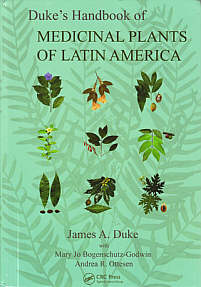
Medicinal Activities
 Further information for practitioners:
World-famous botanist Dr. James Duke attributes the following activities
to this plant (p. 51-53; see hardcopy cover at right),
drawn from the extant literature. (See his graduation for "level of
efficacy" on our amazon traditionals page;
followed by Duke's bibliographic abbreviations (in capital letters),
which we identify
on a separate page.) Further information for practitioners:
World-famous botanist Dr. James Duke attributes the following activities
to this plant (p. 51-53; see hardcopy cover at right),
drawn from the extant literature. (See his graduation for "level of
efficacy" on our amazon traditionals page;
followed by Duke's bibliographic abbreviations (in capital letters),
which we identify
on a separate page.)
- Analgesic (1; DAD; JFM);
- Anthelmintic (f; WO2);
- Antibilious (f:DAW);
- Antidepressant (1; X9401954);
- AntiHIV (1; X9687085);
- Antiinflammatory (f; WO2);
- Antimalarial (1: WO3);
- Antimitotic (1; WO3);
- Antiparasitic (1; X1798795);
- Antiplasmodial (1; WO3);
- Antiscorbutic (f; MPG);
- Antiseptic (1; WO3);
- Antispasmodic (f; KAB; WO2);
- Artemicide (1; MPG);
- Astringent (f; DAW; KAB);
- Cardiodepressant (1; MPG);
- Cardiotonic (f; DAV);
- Cicatrizant (f; DAW);
- CNS-Depressant (f; WO2);
- Cyanogenic (f; EB22:96);
- Cytotoxic (1; WO3; X11473425; X11975482; X7494150);
- Depurative (f; EB30:122);
- Emetic (f; DAW, KAB);
- Febrifuge (f; DAW);
- Filaricide (1; WO3);
- Fungicide (1; X161407);
- Hemostat (f; WO2);
- Hypotensive (1; EB30:122; MPG);
- Insecticide (f; DAW);
- Lactagogue (f; JFM);
- Molluscicide (1; X11315753; X16401556);
- Parasiticide (f1; KAB; MPG; WO2);
- Pectoral (f; DAW);
- Pediculicide (f; DAW);
- Piscicide (f; DAW);
- Plasmodicide (1; MPG; WO3);
- Sedative (f; DAV; EB22:96; RAR);
- Soporific (f; DAW);
- Spasmogenic (1; MPG);
- Stomachic (f; DAW);
- Suppurative (f; KAB);
- Tranquilizer (f; EB22:96)
- Trichomonacide (1; MPG);
- Uterotonic (f; MPG);
- Vermifuge (f; DAW).
Indications
 Further information for practitioners:
Duke provides the following indications for this plant: Further information for practitioners:
Duke provides the following indications for this plant:
- Aphtha (f; KAB; WO2);
- Arthrosis (f; MPG);
- Asthma (f; JFM; MPG);
- Atony (f; NAD);
- Bacillus (1; WO3);
- Biliousness (f; DAW);
- Bleeding (f; WO2);
- Boils (f; DAW);
- Catarrh (f; WO2);
- Childbirth (f; DAW; MPG);
- Cholecystosis (f; EB22:96);
- Colds (f; JFM);
- Coughs (f; DAW; KAB);
- Cramps (f; DAD; KAB);
- Depression (1; X9401954);
- Dermatosis (f; DAW; MPG);
- Diabetes (f; DAV);
- Diarrhea (f; DAW);
- Dysentery (f; DAW; KAB);
- Dyslactea (f; JFM);
- Dyspepsia (f; DAW);
- Dysuria (f; JFM; MPG);
- Enterosis (f; MPG; NAD);
- Fever (f; DAW; KAB);
- Filaria (1; WO3);
- Flu (f; DAW);
- Fungus (1; X161407);
- Gastrosis (f; DAW);
- Hepatosis (f; JFM);
- High Blood Pressures (f1; DAW; EB30:122; MPG);
- HIV (1; X9687085);
- Infection (f1; DAW; WO3; X9687085);
- Inflammation (f; WO2);
- Insomnia (f; DAV: DAW; EB22:96; RAR);
- Jaundice (f; JFM);
- Leprosy (f; MPG);
- Malaria (1; MPG; WO3);
- Mycosis (f; DAW; MPG);
- Nephrosis (f; DAW; MPG);
- Nervousness (f; DAW);
- Pain (f; DAD; JFM; MPG);
- Palpitations (f; DAW);
- Pediculosis (f; DAW);
- Pellagra (f; DAW);
- Ptomaine (f; NAD);
- Rheumatism (f; IHB);
- Rickets (f; DAV);
- Ringworm (f; EB30:122);
- Schistosomiasis (1; X11315753); X16401556);
- Scurvy (f; EB25:436);
- Sores (f; DAW);
- Spasms (f; KAB; DAW; WO2);
- Staphylococcus (1; WO3);
- Stones (f; JFM);
- Syncope (f; DAW);
- Trichomonas (1; MPG);
- Ulcers (f; DAW; MPG);
- Urethrosis (f; MPG);
- Vaginosis (1; MPG);
- Worms (f; DAW; WO2);
- Wounds (f; WO2).
Footnotes
- Taylor, Leslie, The Healing Power of Rainforest Herbs, Square One Publishers, 2005, p. 130
- Ibid., p. 131.
- Duke, James A., Medicinal Plants of Latin America, CRC Press, 2009, p. 53.
- Ibid.
|
 To U.S. Users: To U.S. Users: This product
have not been evaluated by the U.S. Food & Drug Administration.
It is not intended to diagnose, treat, cure, or prevent any disease.
|
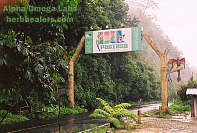 Sourcing From
Sourcing From
The Amazon
 All the materials used to
make our Graviola are wild-crafted and harvested
from the provinces of Pastaza and Moreno Santiago, near the
Peruvian border. There are no cultivated varieties.
Click photo to enlarge.
Dosages &
Ethnobotanical
Usage
 Duke provides a "food pharmacy
potential" score for this plant of, "FNFF=!!!" ("Important enough
in the world to be in many U.S. supermarkets"). Fruit pulp widely consumed
as food, including in U.S. markets; consumed fresh or as beverages,
custards, ice cream, liqueurs, sherberts, used in Cuba's "champola de guan�bana"
and Philippines "nata dy guayabana"; young shoots eaten steamed with
rice (FAC; TAN). Powdered green fruit used for aphthae (stomatitis) and
dysentery (KAB). Leaf tea anthelmintic, antidysenteric, febrifuge, stomachic,
and sudorific, given with sugar for nervousness or palpitations (WO2).
Sudorific leaves and flowers for kidney troubles (WO2). Seeds crushed
and used to kill lice (DAV).
 Here are other ethnobotanical uses cited by Duke (4):
- Flowers or flower buds used for cough in R�union (KAB).
- Roots considered antispasmodicin R�union (KAB).
- Trinidadans use for high blood pressure (X17040567).
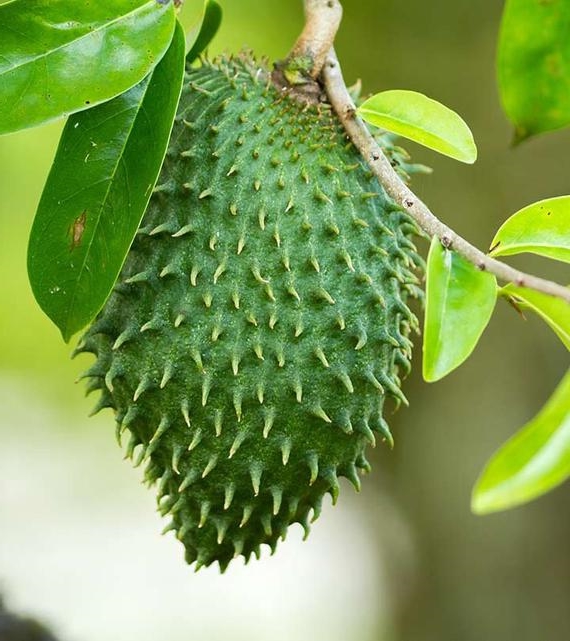
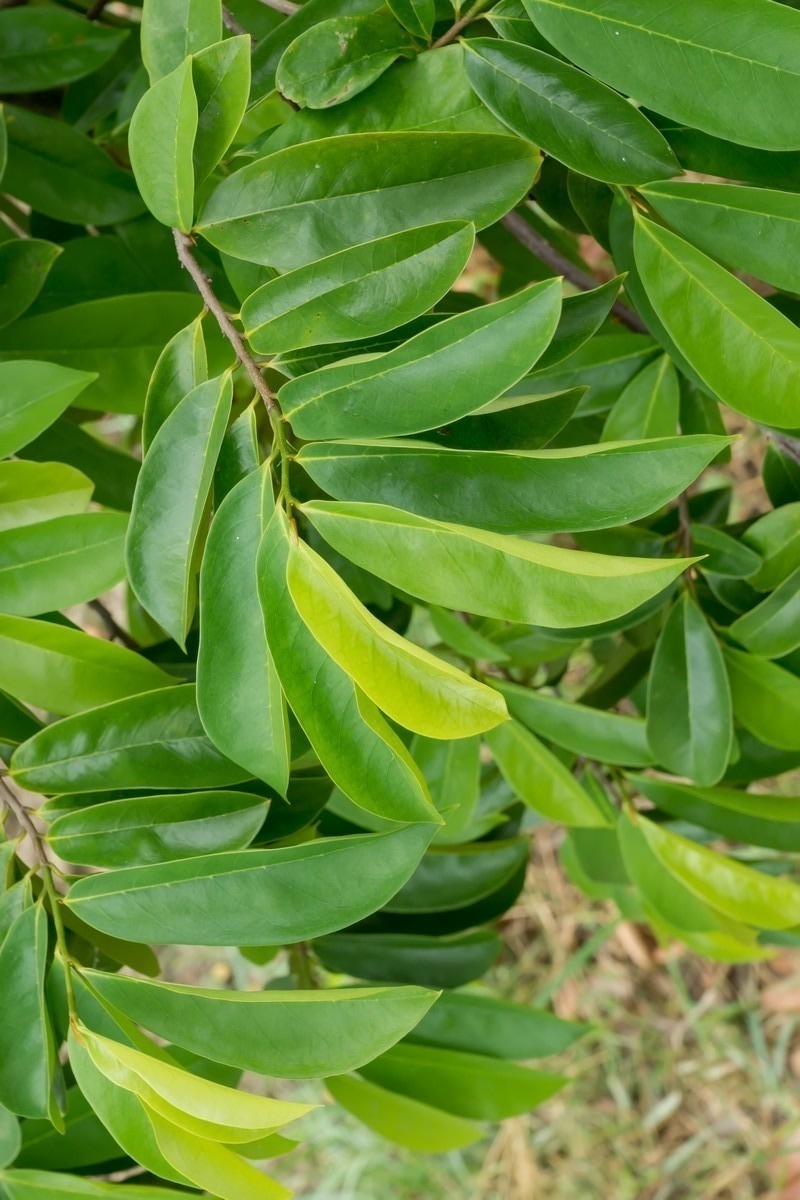
|





